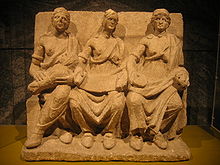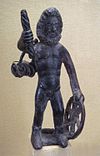- Matres and Matrones
-
The Matres (Latin "mothers"[1]) and Matrones (Latin "matrons"[1]) were female deities venerated in North-West Europe from the 1st to the 5th century AD. They are depicted on votive objects and altars that bear images of goddesses, depicted almost entirely in groups of three, that feature inscriptions (about half of which feature Celtic names, and half of which feature Germanic names), that were venerated in regions of Germania, Eastern Gaul, and upper Italy (with a small distribution elsewhere) that were occupied by the Roman army from the first to the fifth century AD.[2]
Information about the religious practices surrounding the Matres is limited to the stones on which their depictions and inscriptions are found, of which over 1,100 exist.[2] The Germanic matres have been connected with the later Germanic dísir, valkyries, and norns attested largely in 13th century sources.[1]
Matres also appear on votive reliefs and inscriptions in other areas occupied by the Roman army, including southeast Gaul, as at Bibracte (illustration); in Spain and Portugal, where some twenty inscriptions are known, among them several ones which include local epithets like a dedication to the Matribus Gallaicis "to the Galician Mothers"[3]; and also in the Romano-Celtic culture of Pannonia, in the form of similar reliefs and inscriptions to Nutrices Augustae, "the august Nurses" found in Roman sites of Ptuj, Lower Styria.[4]
Contents
Motifs
Matres and Matrones appear depicted on both stones with inscriptions and without, both as altars and votives. All depictions are frontal, they appear almost exclusively in threes with at least one figure holding a basket of fruit in her lap, and the women are either standing or sitting. In some depictions, the middle figure is depicted with loose hair and wearing a headband, and the other two wear head dresses. Other motifs include depictions of sacrifice—including burning incense, pigs, and bowls filled with fruit—and decorations of fruits, plants and trees. In addition, snakes, children, and nappies appear. In most cases, the votive stones and altars are not found singularly, but rather in groups around temple buildings and cult centers.[5]
Rudolf Simek comments that the loose hair may point to maidenhood, whereas the head dresses may refer to married women, the snakes may refer to an association with the souls of the dead or the underworld, and the children and nappies seem to indicate that the Matres and Matrones held a protective function over the family, as well as a particular function as midwives.[5]
Theories
R. Pascal theorizes that The Three Marys may be Christianized versions of the Matres and Matrones.[6]
See also
- Dea Matrona
- Mōdraniht
- Nehalennia
- Triple goddesses
Notes
- ^ a b c Lindow (2001:224).
- ^ a b Simek (2007:204-205).
- ^ CIL II 2776.
- ^ K. Wigand, "Die Nutrices Augustae von Poeticio" Jahreshrift Österreiches Archäologisches Institut 18 (1915), pp 118-218, illus., noted by Susan Scheinberg, "The Bee Maidens of the Homeric Hymn to Hermes" Harvard Studies in Classical Philology 83 (1979), p 2.
- ^ a b Simek (2007:206).
- ^ R. Pascal observed of the pagan sources of Christian liturgical drama ("On the origins of the liturgical drama of the Middle Ages" The Modern Language Review, 36.3 [July 1941:369-387] p. 372) that "the three Maries are a Christianized form of the Celtic-Germanic deities, the mothers (matres, matrones) to whose cult hundreds of Rhenish inscriptions testify"; he offers as a further reference R. Stumpfl, Kultspiele der Germanen als Ursprung des mittelalterlichen Dramas (Berlin, 1936:215ff).
References
- Lindow, John. Norse Mythology: A Guide to the Gods, Heroes, Rituals, and Beliefs. Oxford University Press, 2001, ISBN 0-19-515382-0
- Simek, Rudolf, Dictionary of Northern Mythology. Woodbridge, D.S. Brewer, 2007, ISBN 0-85991-513-1
- Garman, Alex Gustav, The cult of the Matronae in the Roman Rhineland: an historical evaluation of the archaeological evidence (Lewiston, NY: Edwin Mellen Press, 2008), ISBN 978-0-7734-5224-4
Celtic mythology series Supra-regional Alaunus • Alisanos • Andarta • Anextiomarus • Artio • Aveta • Belenus • Belisama • Borvo • Brigantia • Camulus • Cernunnos • Cicolluis • Cissonius • Condatis • Damona • Matrona • Dis Pater • Epona • Erecura • Esus • Genii Cucullati • Grannus • Ialonus Contrebis • Lenus • Litavis • Loucetios • Lugus • Maponos • Matres • Mogons • Nantosuelta • Ogmios • Rosmerta • Segomo • Sirona • Sucellus • Suleviae • Taranis • Toutatis • Virotutis • VisuciusBritannia Gallia Aquitania Gallia Belgica Abnoba • Ancamna • Arduinna • Arvernus • Icovellauna • Inciona • Intarabus • Iovantucarus • Ritona • Veraudunus • Vindonnus • Vosegus • XulsigiaeGallia Celtica Gallia Cisalpina Gallia Narbonensis Germania Inferior Gallaecia Germanic peoples Languages Prehistory Roman Iron Age Migration Period Germanic Iron Age · Alamanni · Anglo-Saxons (Angles · Jutes · Saxons) · Burgundians · Dani · Franks · Frisii · Geats · Goths (Visigoths · Ostrogoths · Valagoths · Gothic Wars) · Gotlanders · Lombards · Suebi · Suiones · Vandals · Varangians · Christianization of the Germanic peoples · RomanizationSociety and culture Mead hall · Poetry · Migration Period art · Runes (Runic calendar) · Sippe · Law (Lawspeaker · Thing) · Calendar · King · Names · Numbers · Romano-Germanic cultureReligion Wodanaz · Veleda · Tuisto · Mannus · Paganism (Anglo-Saxon · Continental Germanic mythology · Frankish · Norse) · Christianity (Arianism · Gothic)Dress Warfare Burial practices Categories:- Ancient Gaulish and British goddesses
- Fertility goddesses
- Germanic paganism
- Mother goddesses
- Deities of the Greco-Roman world
Wikimedia Foundation. 2010.




